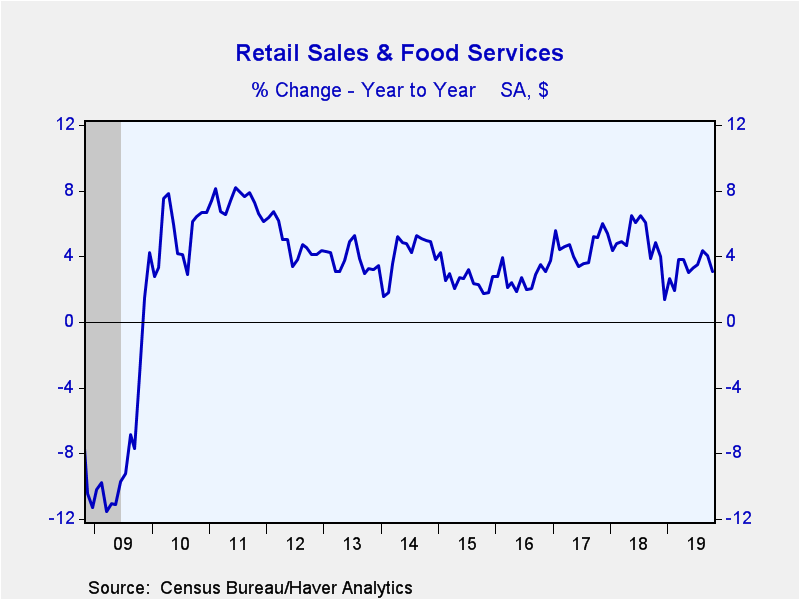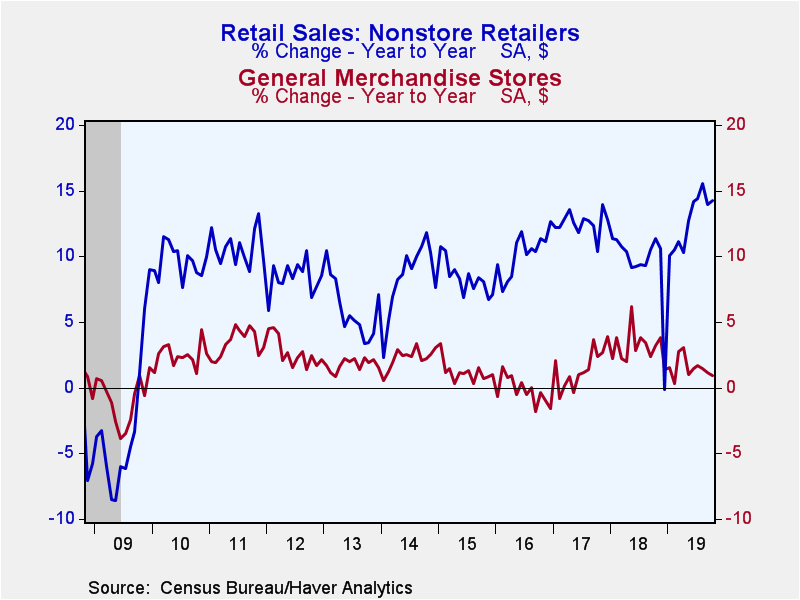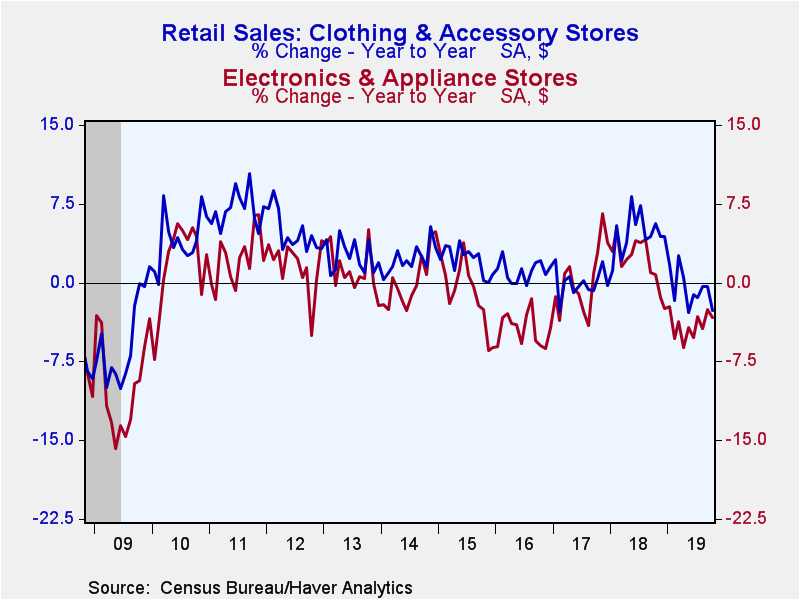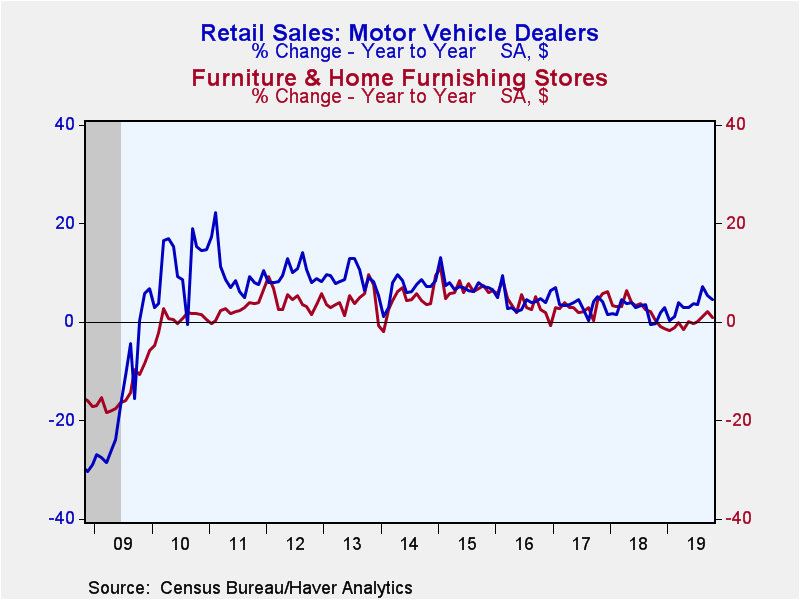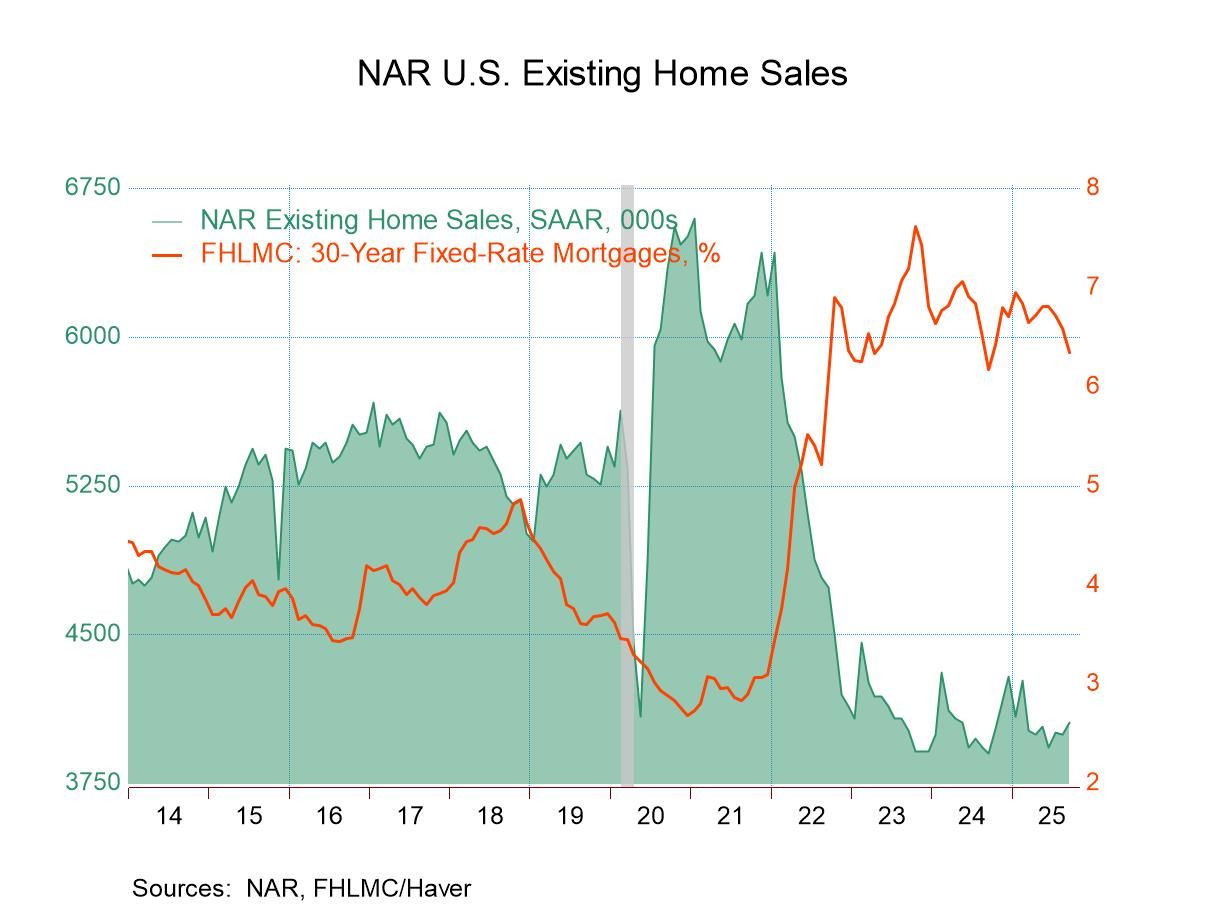 Global| Nov 15 2019
Global| Nov 15 2019U.S. Retail Sales Rebound
by:Tom Moeller
|in:Economy in Brief
Summary
Total retail sales increased 0.3% (3.1% y/y) during October following an unrevised 0.3% September decline. A 0.2% October gain had been expected in the Action Economics Forecast Survey. Retail sales excluding motor vehicles & parts [...]
Total retail sales increased 0.3% (3.1% y/y) during October following an unrevised 0.3% September decline. A 0.2% October gain had been expected in the Action Economics Forecast Survey. Retail sales excluding motor vehicles & parts rose 0.2% (2.8% y/y) last month after slipping 0.1% in September. Expectations had been for a 0.4% improvement. During the third quarter of this year, consumer spending on goods accounted for 1.1 percentage points of the 1.9% gain in real GDP.
Showing strength, a 0.9% increase in online sales last month (14.3% y/y) was an improvement versus September's 0.2% rise. Nevertheless, it was well below the 1.4% increases during each of the prior two months and below the even stronger monthly gains earlier in the year.
Sales of motor vehicles and parts rose 0.5% (4.5% y/y) following a 1.3% September decline. These results compare to a 3.8% decline in unit vehicle sales in October and a 0.9% September rise. Gasoline & service station sales jumped 1.1% (-5.0% y/y) with higher prices following a 0.1% easing.
General merchandise store sales increased 0.4% and followed declines in three of the prior four months. Sales during the last 12 months grew 0.9% versus 6.2% y/y growth in May 2018. Department store sales edged 0.1% higher last month but declined 6.9% y/y.
Declines in sales were logged elsewhere in the retail trade sector. Apparel & accessory store sales weakened 1.0% (-2.7% y/y) after a 0.3% September improvement. Sales at sporting goods, hobby, book & music stores fell 0.8% (+0.2% y/y), the fourth consecutive monthly decline. Sales of furniture & home furnishings were off 0.7% (-1.0% y/y) following a 0.4% rise. Sales of building materials and garden equipment weakened 0.5% (-2.0% y/y) after a 1.8% drop. Electronics & appliance store sales fell 0.4% (-3.4% y/y), the second decline in three months.
Sales of nondiscretionary items were mixed last month. Food & beverage store sales rose 0.5% (3.2% y/y) following a 0.6% September decline. Holding steady were sales at health & personal care stores following a 0.6% rise. The 12-month sales increase also weakened to 1.9% from 6.7% late in 2017.
Restaurant & drinking establishment sales fell 0.3% (+4.7% y/y) following a 0.8% rise.
The retail sales data can be found in Haver's USECON database. The Action Economics forecast is in the AS1REPNA database.
| Retail Spending (% chg) | Oct | Sep | Aug | Oct Y/Y | 2018 | 2017 | 2016 |
|---|---|---|---|---|---|---|---|
| Total Retail Sales & Food Services | 0.3 | -0.3 | 0.6 | 3.1 | 4.9 | 4.2 | 3.0 |
| Excluding Autos | 0.2 | -0.1 | 0.2 | 2.8 | 5.5 | 4.6 | 2.6 |
| Retail Sales | 0.3 | -0.5 | 0.6 | 2.9 | 4.7 | 4.0 | 2.7 |
| Retail Less Autos | 0.3 | -0.2 | 0.2 | 2.4 | 5.3 | 4.4 | 2.1 |
| Motor Vehicle & Parts | 0.5 | -1.3 | 2.0 | 4.5 | 2.6 | 2.8 | 4.4 |
| Gasoline Stations | 1.1 | -0.1 | -1.2 | -5.0 | 12.9 | 8.2 | -5.7 |
| Food Service & Drinking Places Sales | -0.3 | 0.8 | 0.0 | 4.7 | 6.4 | 5.5 | 5.5 |
Tom Moeller
AuthorMore in Author Profile »Prior to joining Haver Analytics in 2000, Mr. Moeller worked as the Economist at Chancellor Capital Management from 1985 to 1999. There, he developed comprehensive economic forecasts and interpreted economic data for equity and fixed income portfolio managers. Also at Chancellor, Mr. Moeller worked as an equity analyst and was responsible for researching and rating companies in the economically sensitive automobile and housing industries for investment in Chancellor’s equity portfolio. Prior to joining Chancellor, Mr. Moeller was an Economist at Citibank from 1979 to 1984. He also analyzed pricing behavior in the metals industry for the Council on Wage and Price Stability in Washington, D.C. In 1999, Mr. Moeller received the award for most accurate forecast from the Forecasters' Club of New York. From 1990 to 1992 he was President of the New York Association for Business Economists. Mr. Moeller earned an M.B.A. in Finance from Fordham University, where he graduated in 1987. He holds a Bachelor of Arts in Economics from George Washington University.


